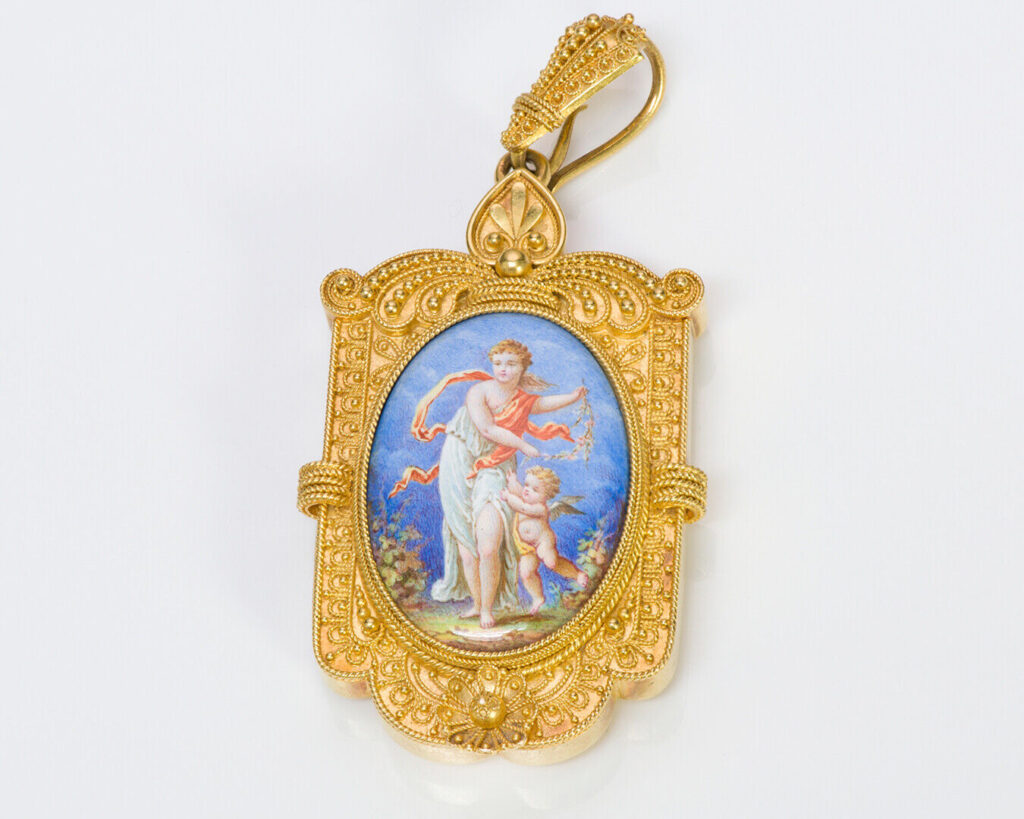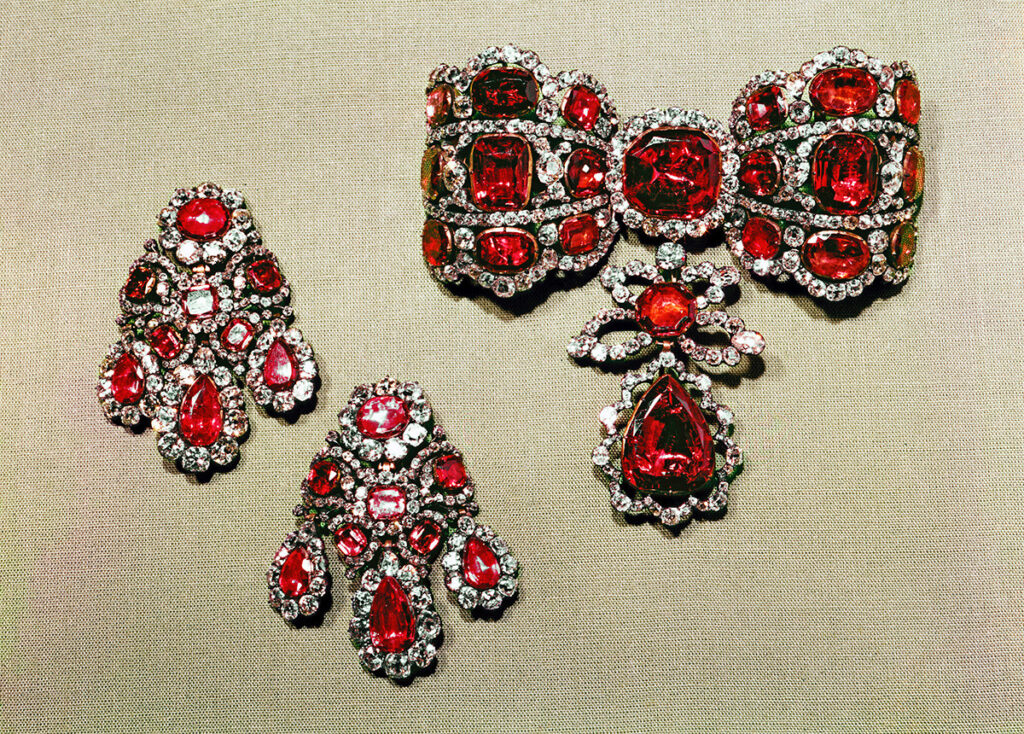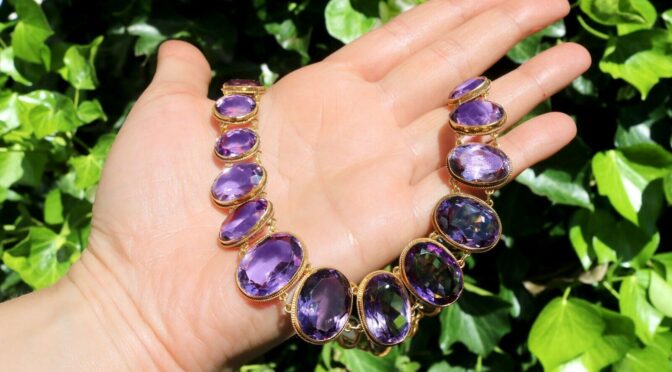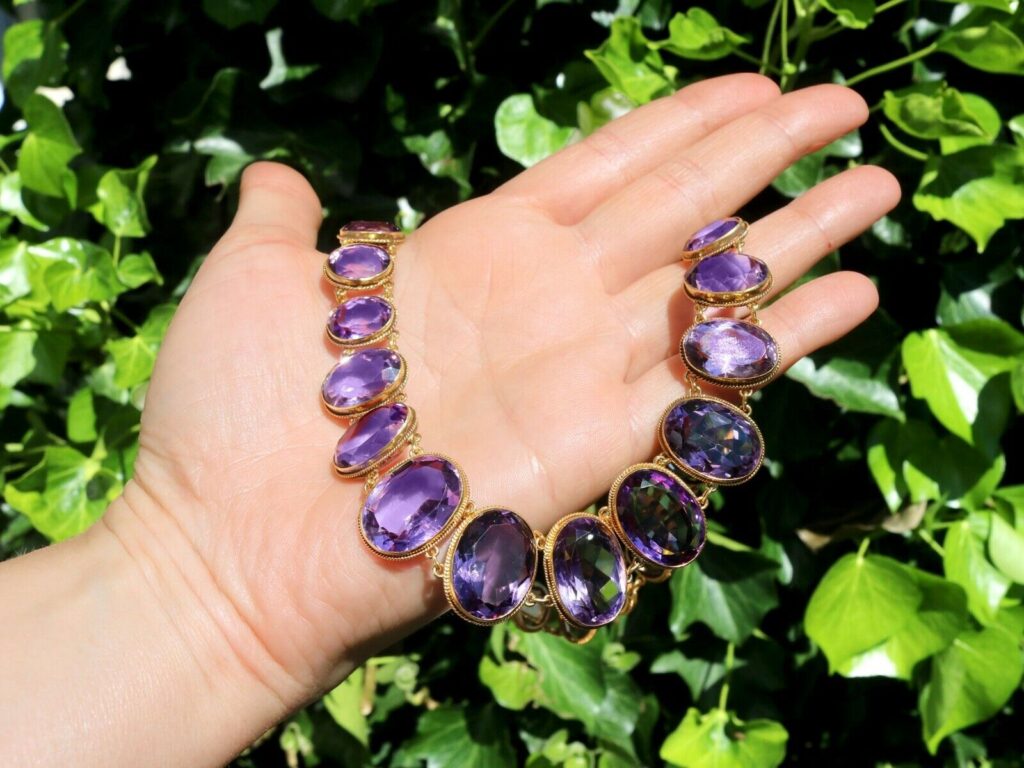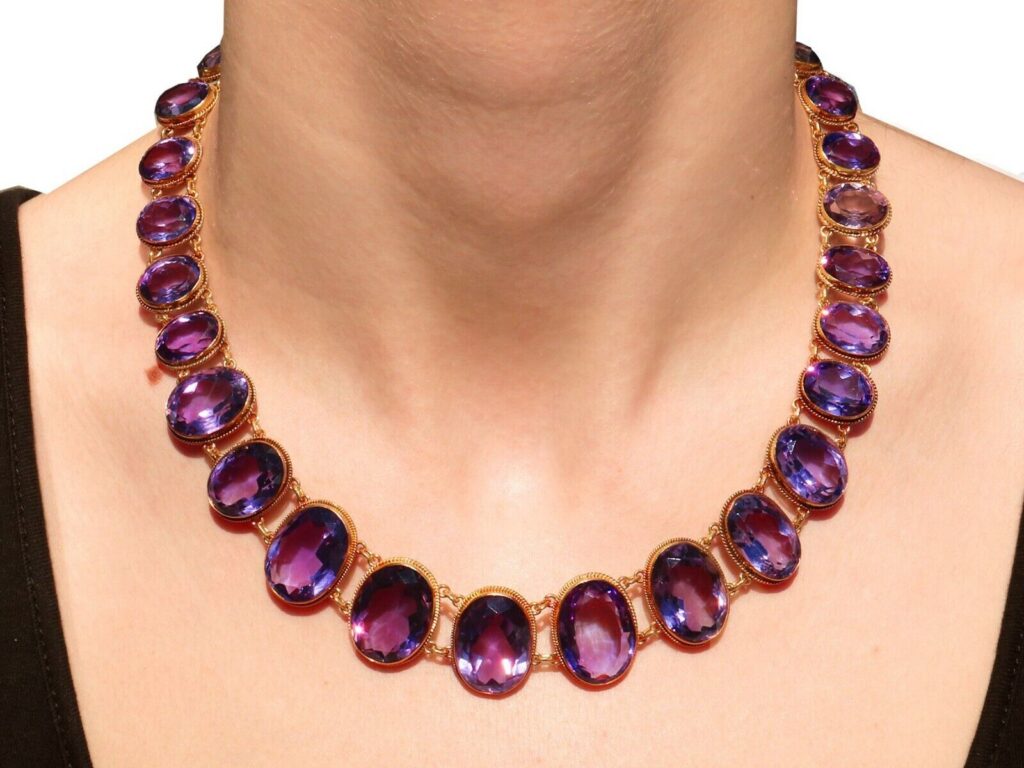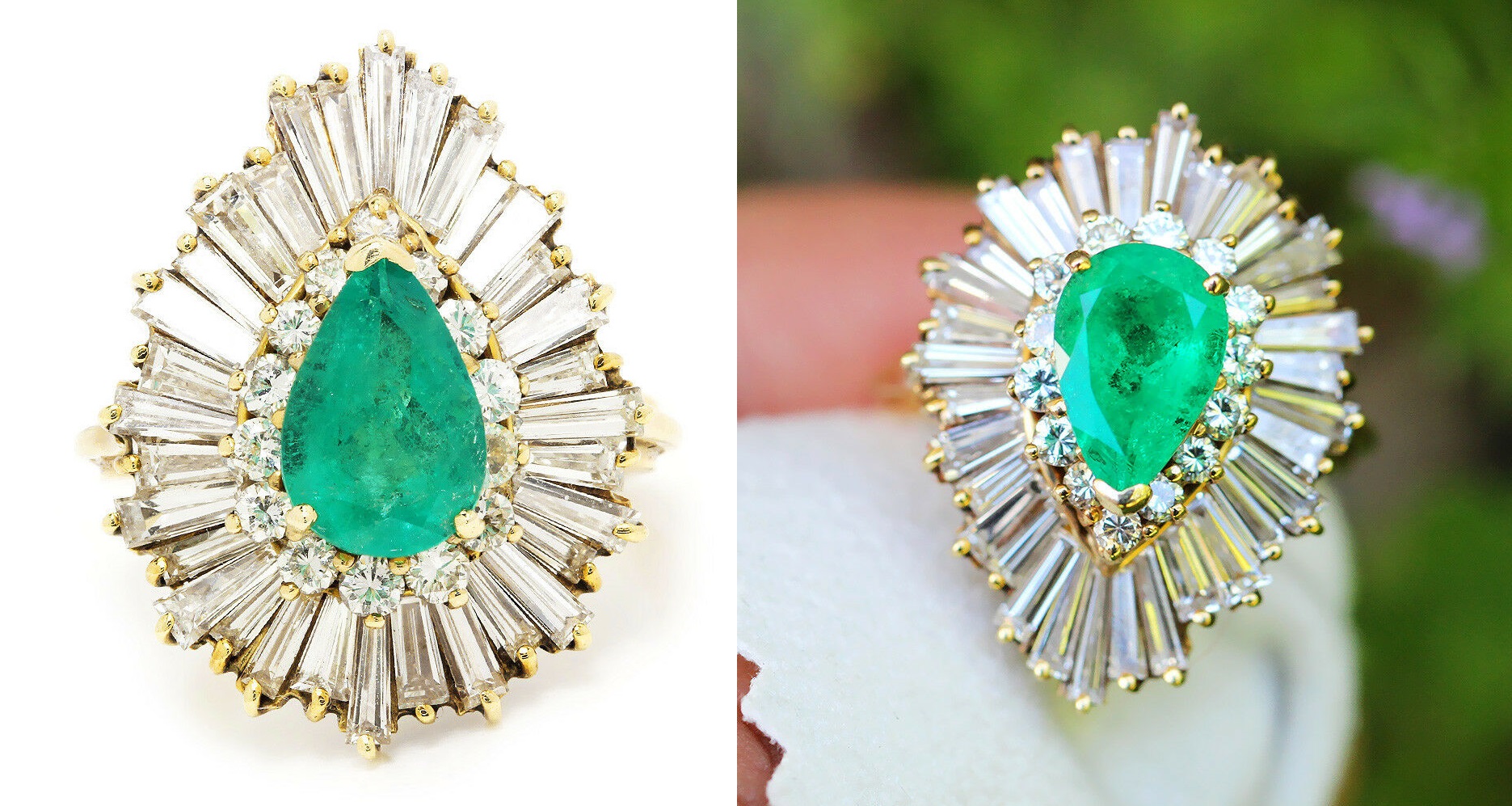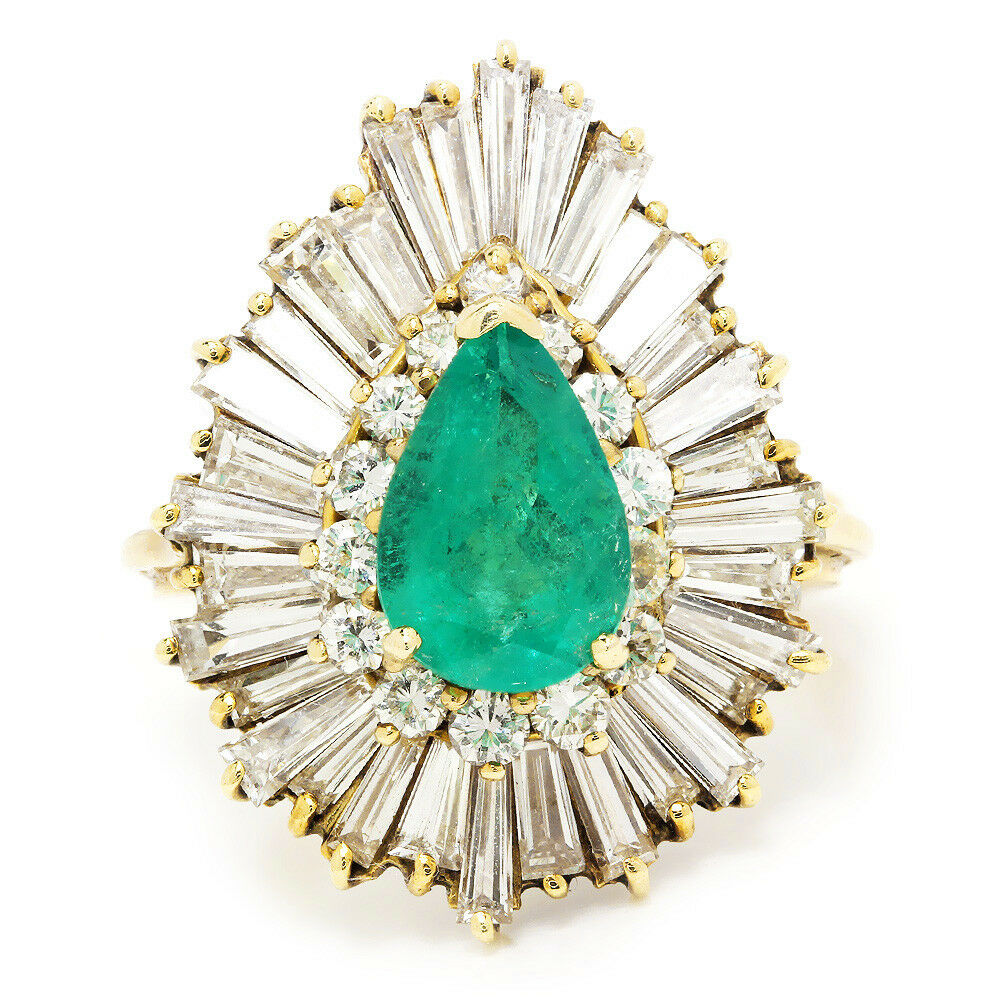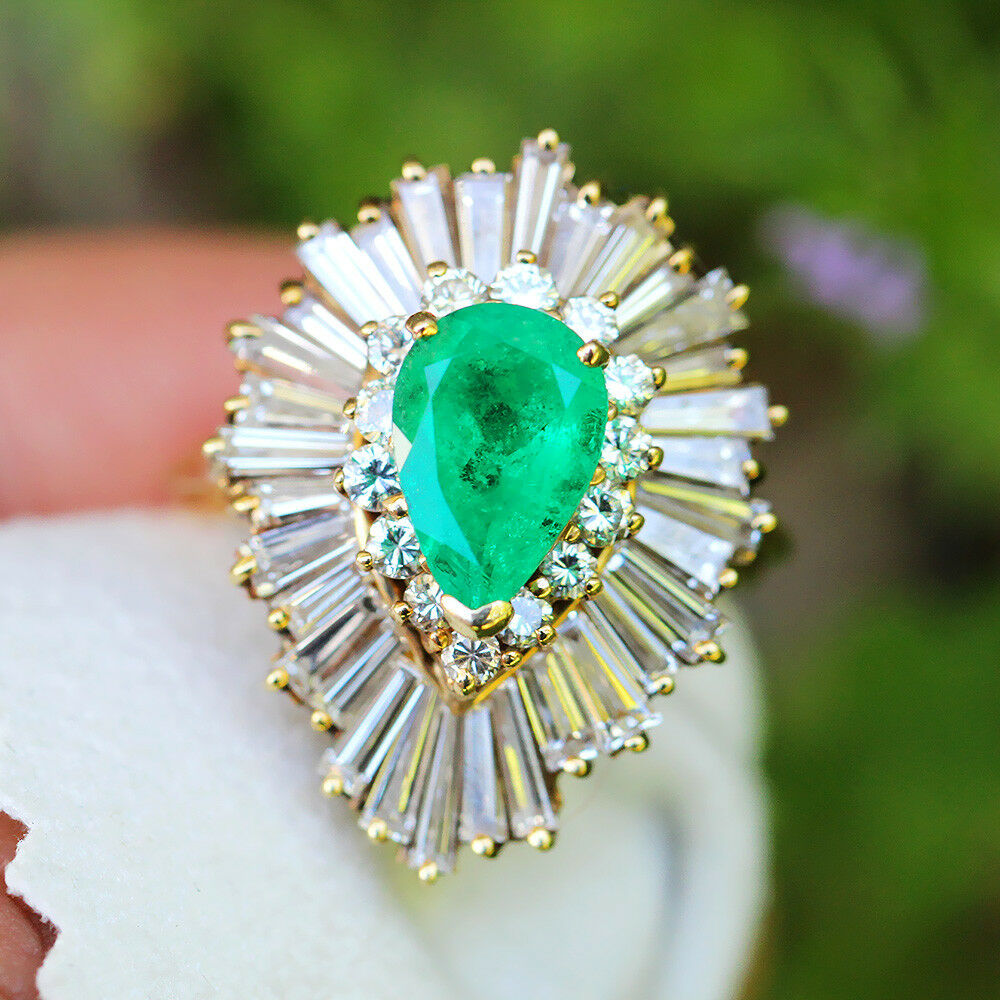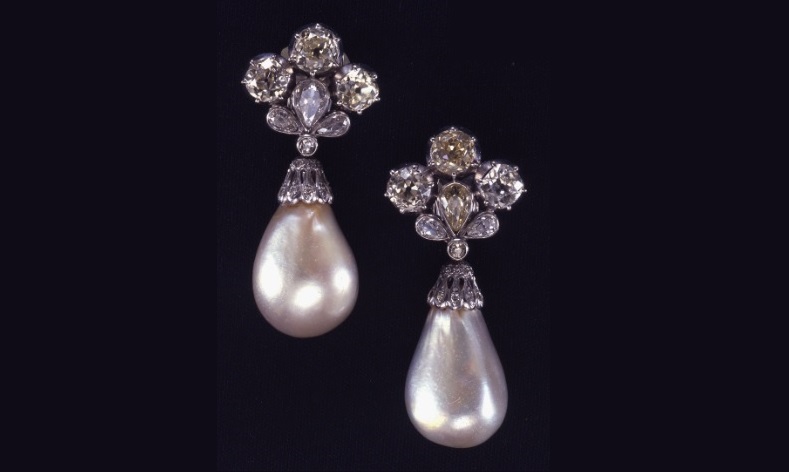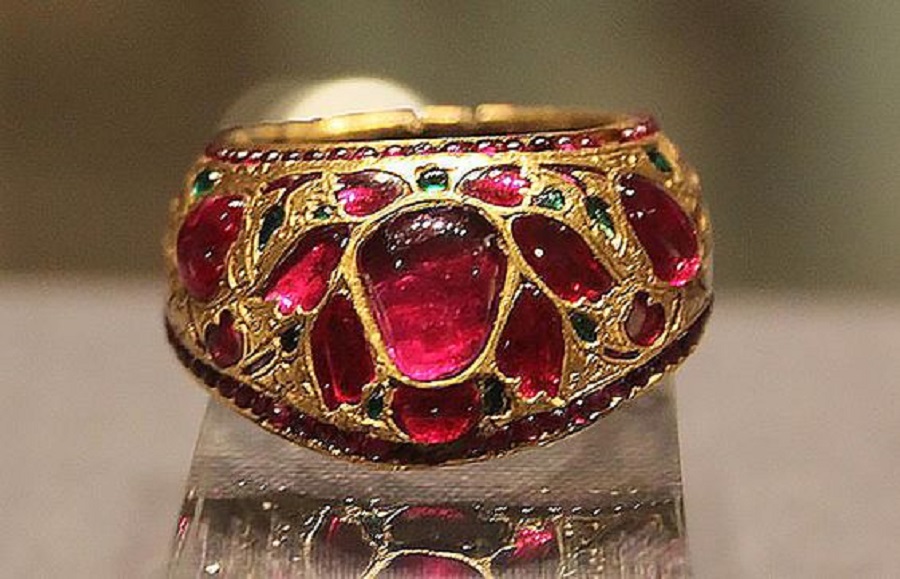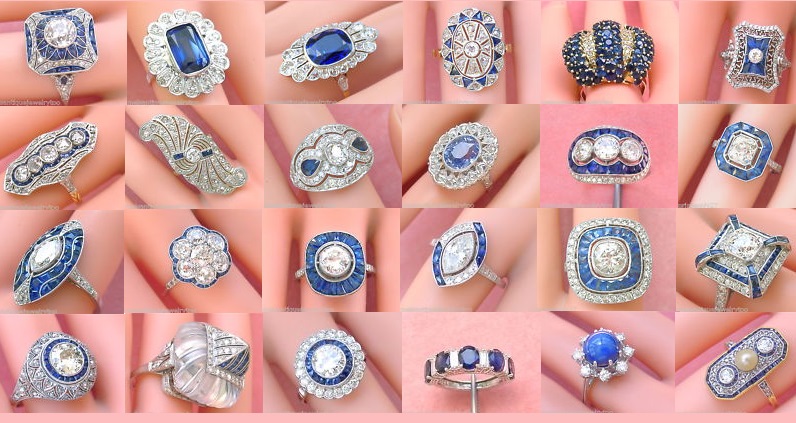Antique Victorian 18K Yellow Gold Enamel Pendant Locket at DSF Antique Jewelry
Tag Archives: Antique
Catherine the Great’s diamond esclavage bow and girandole earrings
Catherine the Great’s diamond esclavage bow and girandole earrings
An esclavage is a piece of jewelry that was worn on a wide lace or velvet ribbon like a necklace. This bow was made for Catherine II in the latest fashion of the time. It is decorated with a scattering of diamonds and spinels, rare minerals of red and pink shades. It is paired with massive girandole earrings—as candelabra-shaped earrings were called then. The gems appear particularly bright thanks to the use of the same foil technique as in the bouquet brooches above. In fact, their natural color is much softer. At the back of the bow there is the jeweler’s stamp reading “Pfisterer 10 Apr. 1764,” while the earrings are dated May 27 of the same year. The last owner of this set was Empress Maria Feodorovna (1847-1928), the wife of Alexander III. It was found in her chambers in the Anichkov Palace in St. Petersburg after she herself managed to escape Russia following the revolution.
Antique Victorian 274.91ct Amethyst and 18ct Yellow Gold Rivière Necklace
Vintage Pear Emerald Ballerina Ring with Diamonds 18K Yellow Gold 5.40ctw
A King’s first love: The Mancini Pearls
Marie Mancini (1639-1715) was the niece of Cardinal Mazarin, the prime minister to King Louis XIV of France. When she fell in love with the young king some spied ambition in the infatuation, but Louis returned her love.
Anne of Austria, Queen Mother of France, violently opposed the romance. Her son’s marriage was political; the ideal fiancée was the Infanta Maria Theresa of Spain, which had long been at war with France. Louis and Marie fought to pursue their love, but in 1659 Marie was forced into exile. Weeks before, Louis bought a string of pearls from his aunt, the Queen of England, who was living in exile in Paris. This was all he could offer the woman he had wished to give his crown.
Marie later married the Italian Prince Colonna, abandoning Louis XIV for good. When leaving France, she took an important collection of jewelry and gems with her. Even while pushing her out, Anne showed Marie great generosity. It was perhaps from Anne that Marie received two enormous pear-shaped pearls weighing approximately 200 grains each. The pearls were passed down through Marie’s descendants for over three centuries, before their sale at Christie’s in Geneva in 1969.
A Gorgeous 17th Century Ruby and Emerald Gold Ring
Exquisite Vintage Sapphire and Diamond Rings
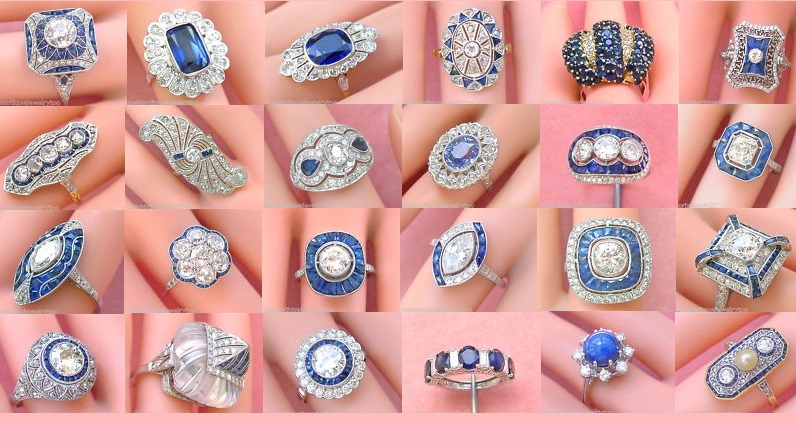
These are a few of the many pieces of gorgeous sapphire and diamond estate jewelry that can be found online, or by actually going to an estate sale. Great prices can be found on sapphire jewelry at estate sales and auctions. Many times you can find stunning designs that are one of kind, and will never be created again. These gorgeous rings have been someone’s treasure for a long time, and many are considered antiques or vintage jewelry. Now you can be the owner of such treasures with a little time and effort in seeking them out. The enjoyment one gets from hunting for such gorgeous treasures can be as much or more fun as wearing these exquisite pieces of jewelry. Estate jewelry can be a rare find, and seeking these treasures will leave you with a satisfaction rarely achieved by many individuals.

This is a absolutely stunning estate ring that was made from platinum in the Art Deco style. The age is unknown. The ring is set with 1 European cut diamond of J (or better) color, VVS clarity that weighs approx. .95 ct. I can not find a single inclusions with my jeweler’s loupe. The diamond measures 6.75 mm with the bezel setting and it is 4.53 mm deep. The ring is additionally set with 52 single cut diamonds of H-I-J color, SI clarity that weigh approx. .40 ctw. These diamonds range in size from .005 -to .03 ct. The ring is detailed with 38 natural blue sapphires that weigh approx. 1.20 ctw. These sapphires are cabochon cuts in various fancy shapes and of the finest quality. The head of the ring measures 9/16” square and it sits almost 3/8” high. The ring size is a 7.75 and the total weight is 5.7 grams.

This is a Gorgeous and original antique ring that was made in the Art Deco style during the 1930s. It is handmade from Platium. The ring is set with 1 round old mine cut diamond (center) of L color, VVS1 clarity that weighs approx. 1.25 ct. The color is in the faint yellow color range and I can not find a single inclusions when using my 10x jeweler’s loupe. It has a tiny tiny nick on the table facet that can not be seen with the naked eye. This diamond measures 7.6 mm with the bezel setting and it is 3.45 mm deep.
The center diamond is framed with 22 natural blue sapphires that weigh approx. .50 ctw. These sapphires are near square shaped and channel set with a darker blue color. The ring is detailed with 36 rose cut diamonds that weigh approx. .38 ctw. These diamonds are white and clear and they have a spread of .01 ct to .04 ct.
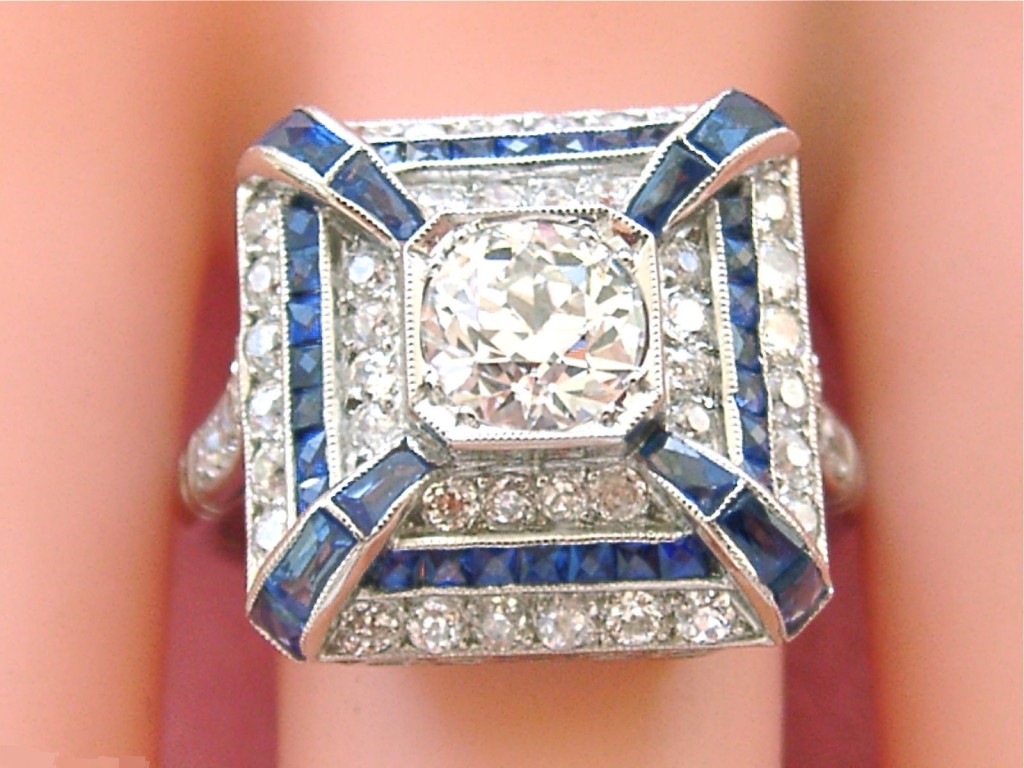
This is an original antique cocktail ring that was made in the Art Deco style during the 1930s. It is handmade from Platinum and originates from France. It has the Mker’s mark ‘LIF’ and a worn ‘PARIS’ stamp. The ring is centrally set with 1 Old European Cut Diamond of G color, SI1 clarity that weighs approx. 1.0 carat. This diamonds has one pinpoint inclusions in the center, but you have to know it is there to find it. Otherwise, this diamond is completely clear and would have a VVS grade. I can not grasp it to get a precise measurement, but it is very close to 6.45 mm in diameter by 4 mm deep.
The ring is also set with 46 roundish old mine cut diamonds of F-G-H color, SI to I clarity that weigh approx. 1.26 ctw. The total diamond weight is approx. 2.26 ctw. The ring is detailed with 40 natural blue sapphires that weigh approx. 1.30 ctw. These sapphires are French cut and channel set of the finest quality.
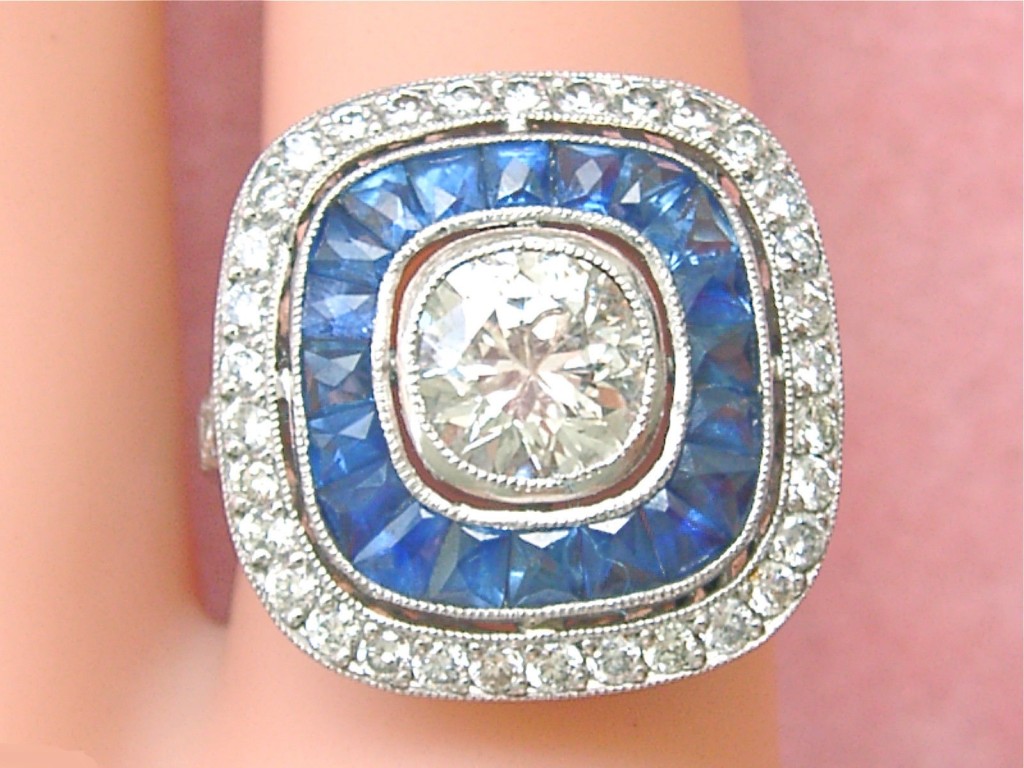
This is an estate cocktail/engagement ring that was made in the Art Deco Style from Platinum. The mounting is post 1950 and the center diamond is an original antique. The ring is centrally bezel-set with 1 European Cut Diamond of J color, I2 clarity that weighs approx. 1.15 ctw. This diamond measures approx. 6.7 mm in diameter and it is 4.27 mm deep. In my opinion, this is the ideal I2 clarity stone. The frame and shoulders of the ring are set with 41 brilliant cut diamonds of G – H color, SI clarity that weigh approx. .82 ctw. The total diamonds weight is approx. 1.97 ctw.
The ring is detailed with a natural blue sapphire halo that is set channel set with 20 sapphires. There are an additional 4 sapphires set in the shoulders. The sapphires are fancy shaped and French cut weighing approx. 1.20 ctw.
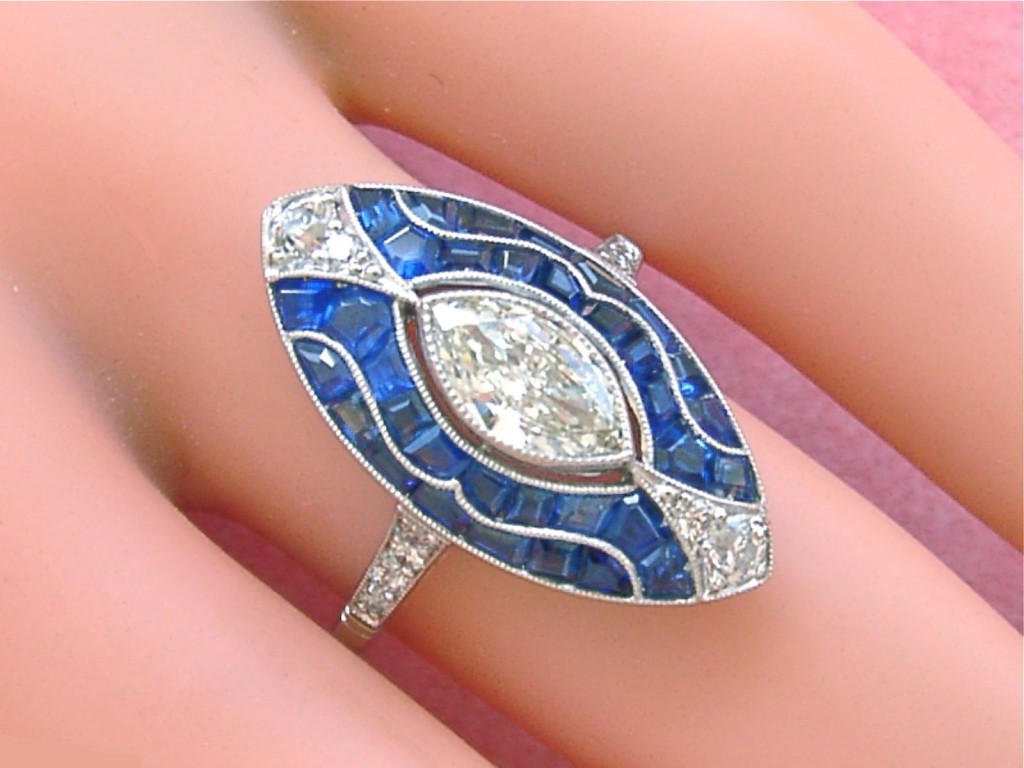
This is a fabulous cocktail ring that was made in the Art Deco style from Platinum. The age is unknown. The ring is centrally bezel-set with 1 marquise cut diamonds of J color, VS or better clarity that weighs .63 ct. and the weight is engraved in the shank. It measures close to 9 x 5.2 x 2.38 mm and I can not find any inclusions with a 10x jeweler’s loupe. The ring is also set with 12 roundish old mine cut diamonds of H color, SI clarity that weigh approx. .38 ctw. The total diamond weight is approx. 1.01 ctw. The ring is detailed with 34 natural blue sapphires that weigh approx. 2.0 ctw. These sapphires are fancy shaped French cuts that are channel set and of the finest quality. The marquise shaped head of the ring measure 1” north to south by 7/16” at the widest point. The total weight is 5.8 grams and the ring size is a 7. The lower gallery is finely detailed.


